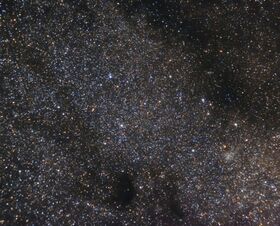Astronomy:Sagittarius Star Cloud
| Messier 24 | |
|---|---|
 M24 with NGC 6603 towards bottom right (south is up) | |
| Observation data (J2000 epoch) | |
| Constellation | Sagittarius |
| Right ascension | 18h 17m |
| Declination | −18° 29′ |
| Distance | ~10 kly (3070 Pc) |
| Apparent magnitude (V) | 4.6 |
| Apparent dimensions (V) | 90′ |
| Physical characteristics | |
| Radius | ~300 |
| Estimated age | 220 million years[citation needed] |
| Other designations | Delle Caustiche,[citation needed] IC 4715 |
The Sagittarius Star Cloud (also known as Messier 24 and IC 4715) is a star cloud in the constellation of Sagittarius, approximately 600 light years wide, which was discovered by Charles Messier in 1764. It is sometimes known as the Small Sagittarius Star Cloud to distinguish it from the Great Sagittarius Star Cloud located to the north of Gamma Sagittarii and Delta Sagittarii.[1]
The stars, clusters and other objects comprising M24 are part of the Sagittarius or Sagittarius-Carina arms of the Milky Way galaxy. Messier described M24 as a "large nebulosity containing many stars" and gave its dimensions as being some 1.5° across. Some sources, improperly, identify M24 as the faint cluster NGC 6603.[citation needed] The location of the Sagittarius Star Cloud is near the Omega Nebula (also known as M17) and open cluster Messier 18, north of M24. M24 is one of only three Messier objects that are not deep sky objects.[2]
M24 fills a space of significant volume to a depth of 10,000 to 16,000 light-years. This is the most dense concentration of individual stars visible using binoculars, with around 1,000 stars visible within a single field of view.[citation needed] The star cloud can be seen visible when the Milky Way itself is visible as well. Without the dust and gas that conceals the Milky Way, M24 holds a collection of numerous kinds of stars that are placed along the Milky Way and through the galaxy's obscuring band of interstellar dust.[2]
HD 167356 is the brightest star that is located within the Sagittarius Star Cloud, a white supergiant with an apparent magnitude of 6.05. This star is an Alpha-2 Canum Venaticorum variable, showing small changes in brightness as it rotates. There are three other stars located in M24 with visual magnitudes between 6.5 and 7.0.[2]
The star cloud incorporates two prominent dark nebulae which are vast clouds of dense, obscuring interstellar dust. This dust blocks light from the more distant stars, which keeps them from being seen from Earth. Lying on the northwestern side is Barnard 92, which is the darkest out of the two. Inside the field filled with stars, the nebula appears as an immense round hole that is devoid of any stars. American astronomer Edward Emerson Barnard discovered this dark nebula in 1913.[2] Along the northeast side contains Barnard 93, which is less obvious and large as the other dark nebula. There are also other dark nebulae within M24, including Barnard 304 and Barnard 307.[2] Both Barnard 92 and 93 have the most significant features shown in M24 due to them both blocking out several stars and being the most visually prominent.[3]
The Sagittarius Star Cloud also holds two planetary nebulae, M 1-43 and NGC 6567. Located within a spiral arm of the Milky Way, Messier 24 holds some similarities with NGC 206, a bright, large star cloud.[2]
See also
References
- ↑ Crossen, Craig; Rhemann, Gerald (2004). Sky Vistas: Astronomy for Binoculars and Richest-Field Telescopes. Springer. p. 137. ISBN 3211008519. https://archive.org/details/springer_10.1007-978-3-7091-0626-6.
- ↑ 2.0 2.1 2.2 2.3 2.4 2.5 "Messier 24: Sagittarius Star Cloud | Messier Objects" (in en-US). http://www.messier-objects.com/messier-24-sagittarius-star-cloud/.
- ↑ French, Sue (2015-07-01). "Small Sagittarius star cloud: the Sagittarius Milky Way is host to dark nebulae and open clusters" (in English). Sky & Telescope 130 (1). http://go.galegroup.com/ps/i.do?p=AONE&id=GALE%7CA417569982&v=2.1&it=r&sid=AONE&asid=7472cfc9.
External links
- Messier 24, SEDS Messier pages
- Merrifield, Michael. "M24 – Sagittarius Star Cloud". Deep Sky Videos. Brady Haran. http://www.deepskyvideos.com/videos/messier/M24_sagittarius_star_cloud.html.
- The Sagittarius Star Cloud on WikiSky: DSS2, SDSS, GALEX, IRAS, Hydrogen α, X-Ray, Astrophoto, Sky Map, Articles and images
Coordinates: ![]() 18h 16.5m 00s, −18° 29′ 00″
18h 16.5m 00s, −18° 29′ 00″


